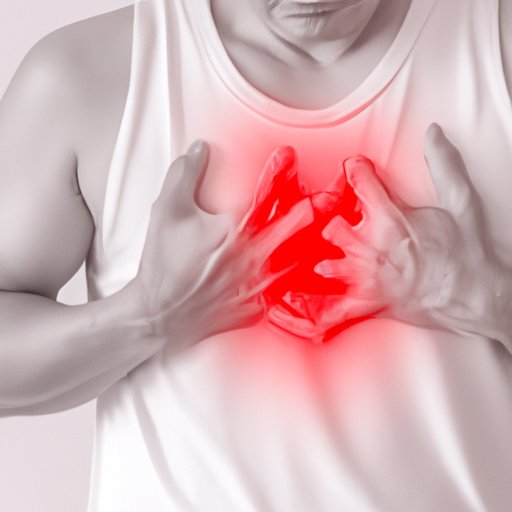I. Introduction
Chest pain is a common symptom that can be caused by a variety of factors, including heart problems, lung issues, and gastrointestinal disorders. However, not all of the chest pain is a medical emergency, and sometimes it can be just muscular pain. Understanding and being able to identify the source of chest pain can help individuals seek appropriate treatment and prevent future incidents. This article will focus on how to tell if chest pain is muscular, identifying the anatomy, common causes, diagnosis, treatment, prevention, and when to seek medical attention for chest pain.
II. Understanding the Anatomy of Chest Muscles
The chest muscles, or pectoral muscles, are located in the upper front of the body and consist of several layers of muscles. The superficial layer of pectoral muscles includes the pectoralis major and the pectoralis minor, which help to move the arms and stabilize the shoulders. The deep layer of chest muscles includes the subclavius and the serratus anterior, which primarily assist with breathing and shoulder movements. The chest wall is also comprised of bones, such as the sternum, ribs, and clavicle. Understanding the anatomy of chest muscles can help individuals identify which specific area of the chest may be affected by muscle pains.
III. Common Causes of Chest Muscle Pain
The most common causes of chest muscle pain include strains or sprains of the pectoral muscles. Chest muscle injuries can result from overuse, trauma, or sudden movements that strain the muscle fibers. Repetitive motions such as weight lifting, push-ups, or sports activities such as tennis and golf are common causes of chest muscle pain. Other causes include poor posture, sudden twists, tears or bruises from accidents, or prolonged immobilization. Chest muscle pain can also occur due to inflammation of the sternum or rib cartilage, also known as costochondritis. The symptoms range from mild to severe chest pain, stiffness, and difficulty breathing.
IV. Diagnosing and Treating Chest Muscle Pain
Diagnosing chest muscle pain can be challenging as it can mimic the symptoms of other types of chest pain. A medical examination by a doctor can help to determine the underlying cause of the pain. Diagnostic tools include imaging tests such as X-rays, CT scans, and MRIs that show the muscle and skeletal structures. Your doctor may also recommend electrocardiogram (ECG) tests to rule out any heart-related issues that could cause chest pain. Treatment of chest muscle pain is aimed at relieving the symptoms, managing the underlying cause, and preventing future episodes of pain. Resting the muscles, heat or ice therapy, over-the-counter anti-inflammatory medications, and physical therapy can help to alleviate pain and improve mobility. Mild chest muscle pain generally improves within a week or two of treatment, but severe or chronic conditions may require longer treatment periods, including nutritional supplements and vitamin D therapy.

V. Risk Factors for Muscular Chest Pain
Several risk factors increase the chance of developing muscular chest pain, including poor posture, sedentary lifestyle, improper lifting techniques, and overweight or obesity. Poor posture, such as slouching over a desk for an extended period, puts additional strain on the chest muscles, leading to muscle fatigue. A sedentary lifestyle that includes little physical activity can lead to weakened muscles, and increased body weight can make the body work harder and strain the chest muscles. Additionally, repeated improper lifting, bending, or twisting of the upper body can result in muscle strains, tears, and sprains.
VI. Relieving and Preventing Muscular Chest Pain
Relieving muscular chest pain includes decreasing inflammation and pain and restoring normal muscle function. Treatment options include rest – allowing the body to recover naturally from the injury – medications to alleviate pain and inflammation, physical therapy to strengthen and stretch the chest muscles, and home remedies such as massage and heat or cold therapy. And to prevent future episodes of chest muscle pain, you need to maintain a healthy lifestyle. Exercise regularly, avoid overuse of the chest muscles, lift heavy objects properly, maintain a healthy weight, correct your posture, and manage any underlying medical conditions contributing to chest muscle pain, such as indigestion or acid reflux.
VII. When to Seek Medical Attention
While not all chest pain indicates a life-threatening emergency, it is crucial to get evaluated by a healthcare provider if the symptoms persist or become severe. Chest pain symptoms such as pressure or discomfort that radiates to one or both arms, neck, back, jaw, or stomach, shortness of breath, sweating, nausea, and light-headedness can indicate a more significant medical issue such as heart attack or pulmonary embolism. If muscular chest pain is accompanied by other symptoms of serious illness, seek medical attention immediately. Additionally, If you have persistent chest pain that does not improve within a few weeks, make an appointment with your physician to evaluate your symptoms effectively.
VIII. Conclusion
Chest pain can be a symptom of many medical conditions and can be alarming, but not all chest pain is life-threatening. Understanding the anatomy, common causes, diagnosis, treatment, prevention, and when to seek medical attention for muscular chest pain can help individuals recover quickly, minimize the pain, and prevent future episodes of chest muscle pain. Remember to maintain a healthy lifestyle, correct your posture, and recognize the warning signs of when to seek medical attention. With a little care and attention, you can quickly recover from muscular chest pain and continue to enjoy an active and healthy lifestyle.
